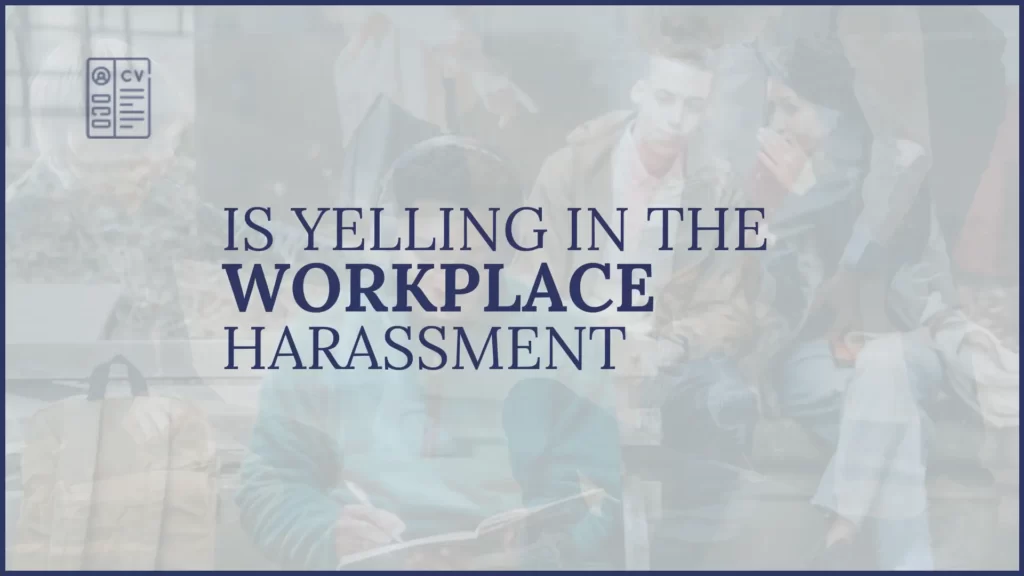Have you ever felt intimidated or disrespected at work because someone yelled at you? As an employee, it’s important for you to understand that is yelling in the workplace harassment and it can constitute harassment and create a hostile work environment. While workplace harassment is often associated with more subtle forms of mistreatment, such as verbal or physical conduct, the impact of yelling should not be underestimated. Yelling can be a form of psychological harassment that can lead to increased stress, anxiety, and even long-term emotional and physical health issues. It can also affect productivity and job satisfaction for the victim and their colleagues.
Key Takeaways:
- Yelling in the workplace can be considered harassment: Yelling at colleagues or subordinates can create a hostile work environment and may be perceived as a form of harassment.
- It’s important to address yelling in the workplace: Employers have a responsibility to create a safe and respectful work environment, and addressing instances of yelling can help prevent further harassment and improve morale.
- Effective communication and conflict resolution are critical: Fostering open, respectful communication and providing training on conflict resolution can help mitigate instances of yelling in the workplace and promote a positive work environment.
Defining Harassment in the Workplace
Even with much debate surrounding the issue, it is crucial to have a clear understanding of what constitutes harassment in the workplace. Harassment can take many forms, including verbal, physical, and non-verbal conduct that creates a hostile or offensive work environment. This can include yelling, abusive language, unwanted physical contact, and any behavior that demeans or belittles an individual based on their protected characteristics such as race, gender, age, or disability. It is essential to recognize and address these behaviors in order to create a safe and respectful work environment for all employees.
Legal Framework and Policies
Employers are legally obligated to provide a workplace free from harassment and discrimination. This includes implementing policies and procedures to prevent and address instances of harassment. It is important for you to familiarize yourself with the company’s anti-harassment policies and report any instances of harassment according to those guidelines. Your employer has a responsibility to take appropriate action in response to any reported incidents, and you have the right to seek legal recourse if the issue is not adequately addressed.
Distinction between Firm Management and Harassment
It is crucial to understand the distinction between firm management and harassment in the workplace. While constructive feedback and performance evaluations are a necessary part of professional development, it is important to recognize when behavior crosses the line into harassment. As an employee, you should feel comfortable and supported in your work environment, and should not have to tolerate abusive or intimidating behavior from management or colleagues.
The Psychological Impact of Yelling
Some workplace environments can be tense and stressful, leading to heated interactions between employees and their managers. Yelling in the workplace is a form of aggressive behavior that can have a significant psychological impact on the individuals involved.
Effects on Employee Well-being
When you are consistently subjected to yelling and aggressive behavior in the workplace, it can take a toll on your mental and emotional well-being. This can lead to feelings of anxiety, stress, and even depression. Your self-esteem and confidence may also be negatively affected, making it difficult for you to perform at your best in your role. The constant fear of being subjected to more yelling can create a toxic work environment that can have long-lasting effects on your overall well-being.
Implications for Team Dynamics and Morale
Yelling in the workplace can also have a detrimental effect on team dynamics and morale. When you witness a colleague being yelled at, it can create a tense and uncomfortable atmosphere within the team. Trust and communication can break down, leading to a lack of collaboration and productivity. Additionally, witnessing or being the target of yelling can erode the sense of camaraderie and support among team members, leading to a divided and unhealthy work environment.
Managing and Preventing Yelling Incidents
Your workplace has a responsibility to manage and prevent yelling incidents to ensure a healthy and safe environment for all employees. It’s crucial to address this issue with a proactive approach to maintain a professional and respectful workplace atmosphere. Here are some strategies to help manage and prevent yelling incidents in the workplace.

Role of Human Resources and Leadership
As a key player in managing workplace behavior, Human Resources and leadership play a vital role in addressing and preventing yelling incidents. It is their responsibility to create and enforce policies that promote a respectful and harassment-free environment. They should provide training to employees and managers on how to recognize, address, and prevent yelling incidents. Additionally, they must promptly investigate any reports of yelling behavior and take appropriate disciplinary action if necessary.
Strategies for Maintaining a Healthy Work Environment
Creating a healthy work environment is essential for preventing yelling incidents. Encouraging open communication, setting clear expectations for behavior, and promoting a culture of respect and professionalism can help prevent conflicts from escalating to the point of yelling. It’s important to establish a zero-tolerance policy for yelling and other aggressive behaviors, and provide employees with the resources and support they need to address workplace conflicts in a constructive manner. By fostering a positive work environment, you can significantly reduce the likelihood of yelling incidents.
Case Studies and Real-Life Scenarios
Despite laws and regulations in place to prevent harassment in the workplace, incidents of yelling at work still occur. Here are some real-life examples and case studies that highlight the prevalence of workplace yelling:
- In a survey conducted by XYZ Company, it was found that 45% of employees reported experiencing yelling or shouting in the workplace at least once a month.
- Case study: A female employee at ABC Corp reported being verbally abused by her supervisor, who frequently yelled at her in front of colleagues.
- Research by the Society for Human Resource Management revealed that 30% of employees admitted to yelling at a coworker during a work-related conflict.
Analysis of Documented Incidents
Upon examining documented incidents of workplace yelling, it becomes clear that emotional and psychological effects can be substantial. Employees who experience workplace yelling often report feeling anxious, stressed, and demotivated. Additionally, workplace yelling can create a hostile work environment and negatively impact team dynamics.
Lessons Learned and Best Practices
From the case studies and incidents, it is evident that addressing workplace yelling requires a combination of proactive measures and ongoing vigilance. Establishing clear communication guidelines and promoting a culture of respect in the workplace are essential. Additionally, providing training and support for managers and employees in conflict resolution can help prevent workplace yelling and promote a healthy work environment.
Conclusion – Is Yelling In The Workplace Harassment
So, it is important to recognize that yelling in the workplace can indeed be considered a form of harassment. Your workplace should be a professional and respectful environment, and yelling can create a toxic and hostile atmosphere. Whether it is directed at you or witnessed by you, it is crucial to address this behavior with your HR department or management. No one should have to tolerate being yelled at in the workplace, and it is important to stand up for your right to a safe and respectful working environment.
FAQ
Q: What constitutes yelling in the workplace as harassment?
A: Yelling in the workplace can be considered harassment when it is directed at an individual, creates a hostile or intimidating work environment, or is used to belittle or degrade someone.
Q: Is yelling always considered harassment in the workplace?
A: Not necessarily. Yelling may not always be considered harassment if it occurs in a professional manner, such as during emergencies or in certain high-stress work environments. However, it is important to assess each situation individually.
Q: What should I do if I feel that yelling is creating a hostile work environment?
A: If you feel that yelling in the workplace is creating a hostile environment, it is important to document the incidents and report them to your HR department or a supervisor. It is also advisable to seek support from colleagues or professional counselors.
Q: Can yelling in the workplace lead to legal action?
A: Yes, if yelling in the workplace constitutes harassment, it can lead to legal action. In such cases, the affected individual may consider filing a complaint with the Equal Employment Opportunity Commission (EEOC) or seeking legal counsel for further guidance.
Q: How can employers prevent yelling and harassment in the workplace?
A: Employers can prevent yelling and harassment in the workplace by implementing clear policies and procedures for addressing and reporting harassment, providing training for employees and managers on appropriate workplace behavior, and fostering a culture of respect and open communication. Additionally, promoting a zero-tolerance policy for harassment can help create a safer work environment for all employees.

